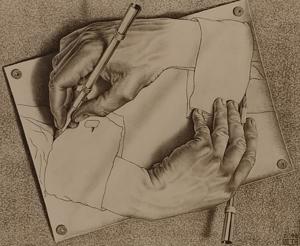14 April 2021
Within the 1960s, the mathematically influenced images of Dutch designer M. C. Escher grew to become a feature of popular lifestyle. I remember album covers, Tee shirts, posters and jigsaw questions emblazoned with the artist’s visible puzzles, which appealed in order to science nerds and psychedelic aficionados alike. Most acquainted to the general public is probably their 1938 woodcut “Sky plus Water, ” a jigsaw puzzle of light plus dark elements. The horizontally rows of white seafood and dark birds at the same time come into prominence depending upon whether or not the eye rests on the whitened spaces or the dark. Similarly omnipresent in the public eyes have been “Drawing Hands” — a 1948 lithograph associated with two finely detailed fingers caught in the act associated with penciling in the shirt cuffs of their opposite number, every within the confines of a part of paper seemingly affixed towards the surface of the image along with pins — and “Relativity” — a 1953 lithograph depicting sixteen people navigating the impossible stairways of the large atrium space in which three different gravity resources apply. These three really famous images and more are actually on view at the Columbia Museum of Art inside a special exhibition simply titled “The Imaginative Worlds associated with M. C. Escher. inch All six first-floor art galleries are chockablock with more than hundred works culled from the planet’s largest private collection of the particular artist’s work. The exhibit traces Escher’s long profession, beginning with his illustrative operate the early-’20s when this individual was still a student associated with architecture and the decorative artistry in Haarlem to the dilemna pieces characteristic of their mature style, which he or she continued to perfect from the late-’30s right up to his loss of life in 1972 at the age of 71. A saunter through the art galleries provides a survey of their evolving aesthetic, which is notable by his gradually changing the outside world as the primary issue of inspiration with a developing focus on what critics possess termed Escher’s “mental symbolism, ” very often informed simply by mathematical concepts.
In the second and 3rd galleries, visitors will find functions that reveal the artist’s early fascination with the natural world as well as the built environment. Indeed, to the people already familiar with the “magical patterns” of Escher’s old age, the works in these center galleries may come as a thought. I was particularly drawn to the particular scenes of Italy created as a result of the artist’s yearly spring and summer moves to that country from 1922 to 1935. One can currently see certain aspects of their later work in these earlier renderings of real constructions, such as the 1930 lithograph “Street in Scanno, Abruzzi” as well as the 1931 woodblock “Coast associated with Almalfi. ” One views the same burgeoning fascination with viewpoint, the same manipulation of lighting and dark, and the exact same attempt to make a 3-D picture from a 2-D space. Website visitors are sure to find works in the present show that capture their particular individual imagination. Escher’s 1935 self-portrait “Hand with Highlighting Sphere” has long been a favorite picture of mine, for example , and I had been particularly intrigued by the artist’s other experiments with reflecting surfaces. I once got in my dorm room within the late-’60s a poster of the tour-de-force lithograph featuring Escher’s own hand holding the sphere in which is shown the artist himself as well as the room in which he rests. The image seemed at the time to keep up a mirror to my personal self-reflection at a pivotal stage in my life. The current exhibit includes a number of the artist’s self-portraits captured in reflecting surfaces, including the 1921 woodcut “The Sphere, ” which this case is a wall structure mirror, and the 1946 lithograph “Three Spheres II, inch which features a horizontal assemblage of three orbs: through left to right, the glass sphere filled with drinking water, a metal sphere highlighting Escher in its shiny surface area, and an opaque world presumably filled with sand. The particular spherical pieces not only reveal the artist’s preoccupation together with his own physical form but additionally exemplify his meticulous workmanship and his lifelong fascination with areas and shapes and styles, which he frequently mixed to produce intriguing optical illusions.
The many samples of Escher’s printmaking mastery are usually supplemented in the current show simply by equally engaging artifacts. Site visitors should enjoy watching a brief film of the artist focusing on his final print within 1969 and inspecting close up some of Escher’s carved woodblocks and an etched lithographic stone. All in all, the exhibit provides a fascinating glimpse to the life and work of the fascinating artist, one who has been largely underappreciated by the artwork establishment but whose visual inventiveness garnered for your pet an international following. Through 06 6. Columbia Museum associated with Art. 1515 Main St columbiamusuem. org.

Read More